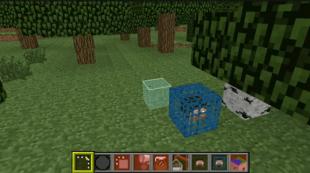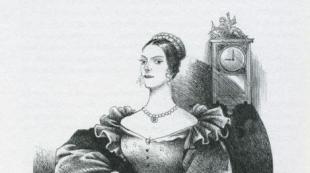The double role of the letters e, yo, yu, i. What is the dual role of the letters e, ё, yu, i The dual role of vowels
The double role of the letters E, Yo, Yu, I
Let's find out how the letters e, ё, yu, i differ from other vowels.
First, look at the transcription and determine which words are in front of you.
If you look closely at the recording of these words (spruce, forest, linen, honey, water, dish, anchor, meat), you will notice that they contain the letters e, e, y or i. But they correspond to different sounds! Why?
The thing is that in everyday life we regularly encounter various phonetic processes taking place in the language. One of them is the positional alternation of sounds, i.e. such an alternation (replacement), which depends on the place (position) of the sound in the word. A letter is a special sign that is used to denote sound in writing, because sound can only be heard or pronounced. There are much more sounds in Russian than letters. Therefore, there is nothing surprising in the fact that some letters "have to" denote several sounds. So it happened with the letters E, Yo, Yu, Ya.
To figure out in which cases these vowels denote one sound, and in which two, we will do the following work. Let's pronounce the words and analyze the position of the vowels of interest to us.
So. M [e] ra, pol [o] t, cl [y] v, s [i] du. In all these words, the letters e, e, yu, i denote one sound, they stand after soft consonants.
Now let's look at the following examples: [ye] m, [yo] lka, [yy] g, [ya] shcher. Here vowels are used to denote two sounds ([ye], [yo], [yu], [ya]), and they stand at the absolute beginning of the word.
Another group of words: bo [ye] ts, pri [yo] m, ka [yu] ta, hundred [ya] t. In these words, the letters e, e, yu, i also denote two sounds, but they are already after another vowel.
And more examples: ot [ye] zd, s [yo] mka, v [yu] ha, monkey [ya] na. The vowels e, e, yu, i again denote two sounds, and in the word they stand after ъ or b.
Now, I think you can easily formulate a rule:
The letters e, e, yu, i denote two sounds if they are at the beginning of a word, after any other vowel, or after hard and soft signs. These letters designate one sound if they stand after a consonant and indicate its softness.
The sounds denoted by the letters e, e, yu, i are called iotated, because the sound y or iot participates in their formation. In transcription, it is denoted as [d], and sometimes as [j].
Studying the section "Phonetics", we can see once again how rich, diverse and amazingly beautiful the Russian language is. But the Russian language is also considered one of the most difficult in the world. One of the difficulties of our language is that many words are spelled differently from the way they are heard. Taking care of the beauty and correctness of your speech is essential. Otherwise, you can get into such an absurd situation, which the poet Alexander Shibaev writes about in his poem "Sad News":

List of used literature:
- Ladyzhenskaya T.A., Baranov M.T., Trostentsova L.A. Russian language. Textbook for grade 5. - M .: Education, 2008-2012.
- Stronskaya I.M. A guide to the Russian language for students in grades 5-9. - SPB .: Publishing House "Literatura", 2012.
- Razumovskaya M.M., Lvova S.I., Kapinos V.I. etc. Russian language: Textbooks for 5, 6, 7, 8, 9 grades. educational institutions / Ed. MM. Razumovskaya, P.A. Lecant. - M .: Bustard.
- Arsiriy A.T. Entertaining materials on the Russian language: Book for students / Ed. L.P. Krysina - M .: Education, 1995.
- Kalmykova I.R. The mysterious world of sounds. Phonetics and culture of speech in games and exercises. - Yaroslavl: Academy of Development, 1998.
- Golub I.B., Kokhtev N.N., Rosenthal D.E. Russian language. Sounds, letters, words / A book about language for the curious. - M .: "MICH" with the participation of JSC "Century", 1998.
- Egorova N.V. Lesson developments in the Russian language. Grade 5. - M .: Vako, 2013.
- Vasiliev I.P. Russian language lessons for the textbook by SI Lvova. A guide for the teacher. - M., 2013.
- Sychugova L.P. Summaries of lessons for the teacher of the Russian language. Grade 5. - Vlados, 2004.
- Gribanskaya E., Novikova L. Control and verification work in the Russian language for the textbook “Russian language. Grade 5 ". Educational and practical guide. - L .: Exam, 2004.
- Bogdanova G.A. Russian language lessons in grade 5. Teacher's book - Genzher, 2000.
- I.B. Golub, D.E. Rosenthal. "Secrets of Good Speech". - M .: Mezhdunar. relationship, 1993.
6. Combinations of letters with an unpronounceable consonant sound:
STN = [si]: sad
ZDN = [zn]: star
RDC = [RTS]: heart
Lnz = [nts]: sun
7. Features of the pronunciation of some combinations of consonants
CHN - [SHN] in words: boring, of course, birdhouse, scrambled eggs, trifling, Ilyinichna
TH = [PC] in words: what, to, something, something, etc.
SCh, ZhCh, SCH, ZSC, 34 = [SCH "]: comb, deserter, generous, without a brush, without a watch, etc.
SSh, ZSh = [Sh]: silent, without a scarf, etc.
TC (i), TC (i), DS, TC = [C]: learns, learn, ugliness, brothers, etc. GK = [XK], [X "K"]: easy MS =: easier
8. Features of pronunciation of some grammatical forms
In the endings -ОGO- (-HEO-) of adjectives, participles and pronouns, a consonant sound [B] is pronounced: beautiful, flying, one's own.
Specificity of the letters b and b
The letters b and b do not denote sounds.
Algorithm for the task A4:
1. If you need to determine the ratio of letters and sounds in a word, you should remember that
Letters b and b sounds do not mean;
Letters E. Y. Yu. I can mean two sounds
a) at the beginning of the word (PIT, HEDGEHOG);
b) after the vowels (SHINE, FIGHTER);
c) after b and b (DRINK, ENTRANCE).
The following letter combinations are pronounced as one sound:
a) SCh, ZhCh, SSh, ZSch, 34 = [Щ "]: comb, deserter, get generous, no brush, no watch, etc .;
b) SSh, ZSh = [Sh]: silent, without a scarf, etc .;
c) TC (i), TC (i), DS, TC = [C]: studies, study, ugliness, brothers, etc.
The following letter combinations contain unpronounceable consonants:
a) STN = [SN]: sad;
b) ZDN = [zn]: star;
c) RDC = [rts]: heart;
d) lnz = [nts]: sun.
2. If you need to determine in which words all consonants are hard or in which words all consonants are soft, remember that
The letters E, Y, Y, Y, L indicate the softness of the preceding consonant;
In letter combinations ШЬ, ЖЬ, the letter L (soft sign) does not indicate the softness of the consonant (the sounds Ж, Ш are always unpaired, hard), but indicates a certain grammatical form:
a) rye, mouse - b sign shows that we are dealing with nouns of the 3rd declension;
b) eat, cut - the b sign shows that we have a form of the imperative mood of the verb;
c) you go, you say - the b sign shows that we have the form of the 2nd person singular of the verb;
A word can always contain a soft unpaired invisible sound [Y "], denoted in writing with the letters E, Y, Y, Y, if they go at the beginning of the word (YAMA, HEDGEHOG); after the vowels (SHINE, FIGHTER); after B and b (DRINK, ENTRANCE).
Note: sometimes students forget about the existence of this sound and therefore mistakenly believe that, for example, in the word YABLOKO, all consonants are solid.
3. If you need to determine in which words all consonants are voiced or in which juvah all consonants are deaf, remember that
all voiceless consonants allows you to remember the following phrase: FOKA, DO YOU WANT TO EAT a cheek?
all voiced consonants allows you to remember another phrase: OH, WE DIDN'T FORGET ABOUT ANOTHER!
A voiced consonant at the end of a word or before a voiceless consonant is pronounced as a voiceless one: OAK [SOUL; TALE [SKA SKA].
A voiceless consonant before a voiced consonant is pronounced like a voiced one: PLEASE [PROTSBA].
JOB A5
What a student should know when completing assignment A5: spelling of roots with a checked unstressed vowel; spelling of roots with alternating vowels; dictionary words with unchecked unstressed vowels at the root, requiring memorization.
1. Checked unstressed vowels at the root of the word
In an unstressed position, the same vowel letter is written at the root of the word as under stress in the same root words or forms of this word:
Unstressed vowel sound
It causes a lot of anguish.
So that there is no doubt
We put the sound under stress.
Vowel stress
Can make the letter clear.
Example: serial - gray; washed - washing, humble - dirty, enchanted - enchant, ambitious - honor.
Checking an unstressed vowel at the root is possible by selecting the form of the same word. For this you need:
For nouns, change the number: spring - spring, sails - parus;
For adjectives, replace the full form with a short one: naked - he is nAg, barefoot - he is 60s;
For verbs:
A) change the number: I wander - we wander;
B) change the time: showed - show;
B) change gender (for past tense verbs): withdrawn - withdrawn.
When choosing one-root words, one should distinguish between words that are similar in sound, different in meaning and spelling. The correct selection of a test word for them depends on the meaning of the original word:
1.the old resident of our city (= old resident) - he was guarding the warehouse (= the guard)
2.beg for mercy (= he Molit) - to belittle the meaning (to make it small)
3.Unload the gun (= discharge) - thin the carrots (= sparse)
4.Irritate with behavior (= someone else) - tremble from the cold (others)
5.Bless for feat (= say a good word) - glorify the hero (= slave)
6.punish the enemy (= punishment) - conquer nature (= submissive) - reproach for laziness (= ukOr)
7.devote a poem (= holiness) - shine a candle (= light)
8.seeing from afar (= uvIdit) - fade without moisture (= fade)
9. to calm down gradually (= to calm down) - to comfort gently (= to calm down)
10.flag fluttering (= VEAT) - the child develops (= development)
I. The letters e, e, yu, i can denote combinations of sounds
d + o; d + y; d + a.
II. The same letters e, e, yu, i after the consonant letter denote one vowel sound e, o, y, and and the softness of the previous consonant.
The letters e, e, yu, i denote two sounds:
1. If they are at the beginning of a word.
whirligig apple
2. If they come after a vowel.
singing cabin
3. If they are after the dividing
B or b.
shooting family
Output:
The letters e, e, yu, i at the beginning of the word, after the vowel and after the dividing ones b and b denote 2 sounds - d e, y y, y o, y a.
The letters e, e, yu, i after the consonant denote one vowel sound e, o, y, and the softness of the previous consonant.
Sounds u, I, e, ё no, there are u, a, uh, oh.
Syllable - it is a part of a word pronounced in one breath, with a push.
Stress - it is the pronunciation of any syllable with the greatest vocal power. apple, day.
The Russian accent has a different character.
Phonetic parsing words are a characteristic in a word of speech sounds.
Order phonetic parsing.
1. Syllables, stress.
2. Vowel sounds: percussion and unstressed; what letters are designated.
3. Consonant sounds: voiced and deaf, hard and soft, what letters are indicated.
4. The number of sounds and letters.
My native country is wide.
native 2 syllables native - 6 letters, 7 sounds.
p - p - consonant, voiced, solid
o - a - vowel sound, unstressed
d - d - consonant, voiced, solid
n - n - consonant, voiced, solid
a - a - vowel, stressed
I - th - consonant, voiced, soft
a - vowel, unstressed.
yeast - 6 letters, 5 sounds, because 2 letters Ж - one long sound Ж.
long - 7 letters, 6 sounds, because 2 letters n form one long sound n.
laughs - laughs, 3 syllables, 7 letters, 7 sounds.
m - m - agree, call, soft
e - and - vowel., bezud.
ё - and - vowel., bezud.
o - vowel, shock
with c - agree, hard, deaf.
I a - vowel., unstressed.
oral oral, 2 syllables, 6 letters, 5 sounds.
u - u - vowel, shock
s - s - agree., deaf., hard.
n - n - agree., call., firm.
s - s - public., bezud.
th - th - agree, soft, call.
40. Vocabulary - it is the vocabulary of a particular language, that is, the words of the language.
Lexicology - it is a branch of the science of language in which vocabulary is studied.
Word - it is the basic unit of language that is studied in lexicology.
Sounds, word, sentence - these are the basic units of the language. Words are used in the language for the names of objects, actions, quantity, attributes of an object.
Lexicon - it is the vocabulary of words and expressions of the same person.
The lexical meaning of the word - this is its meaning, meaning, this is what the word means.
The word has 2 meanings: lexical and grammatical.
Polisimy - this is the ambiguity of the word.
Unambiguous words - these are words that have the same lexical meaning.
Ambiguous words - these are words that have several lexical meanings. Polysemous words call different objects, signs, actions in something similar.
Differences between unambiguous and ambiguous words
1. An unambiguous word names one object (sign, action), and a polysemantic one several.
2. An unambiguous word has one lexical meaning, while a polysemantic word has several lexical meanings.
Class: 5
During the classes
1. Organizational moment
2. The teacher's word
- Hello! Do you guys like visiting? Today our lesson will be held in a playful way. We will visit the sounds of speech and will definitely make a discovery, unravel the secret that vowels hide from us.
Open your notebooks and write down the number.
But it is indecent to go to visit without gifts. What should we give us? Of course, our knowledge. Are you ready for the challenge? And here is the first task.
3. Testing knowledge
Exercise 1
Collect a sentence from scattered words.
Parse the sentence, give its oral description, draw a sentence outline.
(The sentence is narrative, complex, consists of two simple sentences. In the first sentence, the basis is that the snowflakes are falling, in the second, everything is obscured.
Simple sentences are connected in a compound complex with the help of intonation and union and, separated by a comma. [, and ].)
- Guys, describe the consonants in the word white
[b ’] - consonant, voiced, soft
[l] - consonant, voiced, solid
Assignment 2
- You know that the sounds of speech make up words, each word denotes a concept. Do the sounds of speech have such a property - to designate a concept? Pronounce sounds:
[b] [p] [c] and [a] [o] [and]
- Will it be clear what you wanted to say if you pronounce each sound individually or in the order in which they are given? ( No.)
- Compose words using only vowels or only consonants. Is it possible to do this? Now combine them and make up as many words as possible using these sounds. Write the words down in a notebook.
Let's conclude: By themselves, the sounds of speech do not denote any concept, but if you choose them in a certain way, we can get a word.
4. Acquaintance with the new topic of the lesson
- Guys, a wise owl has prepared riddles for you. If you guess what letters they are talking about, you will slightly open the veil of the mystery of vowels.
It's such a pity in the yard! -
Our ladder broke.
Our ladder broke
The letter ... but it remained ... (E)The letter E rested,
How immediately to her
A couple of chicks fluttered -
It turned out to be a letter ... (Yo)So that O does not roll away,
I'll nail it tightly to the post.
Oh look,
What's happened:
It turned out to be a letter ... (NS)Look, friends,
I made a birdhouse.
And flew into the birdhouse
Instead of a bird - a letter ... (I AM)
- You guessed the letters correctly, but what secret do they hide?
- Let's try to pronounce these letters. What sounds are heard?
Output.
- So the letters e, e, NS, I am stand for two sounds.
e - [th "e],
ё - [th "o],
y - [y "y],
I - [th "a]
- But do the letters e, e, yu, i always mean two sounds. Look closely at the board.
m e l [m " NS l]
m e d [m " O T]
l NS k [l " at To]
R I am d [p " a T]
- Let's write down the transcription of these words and see what sounds represent the letters e, e, NS, I am.
Let's check the recorded transcription in notebooks with a blackboard. Is everything right with you? (I open the curtain part of the slide gradually, where the transcription of words is recorded).
- Where are the letters e, e, NS, I am in the words of this column? ( After the consonant.)
- How many and what sounds do they mean? ( One sound [uh, oh, u, ah].)
- What consonants stand in front of vowel sounds? ( Soft.)
Let's make a conclusion.
If the letters e, e, NS, I am stand after a consonant, they denote one sound [uh oh uh uh] and soften the previous consonant.
So the first role of letters e, e, NS, I am Is a softening of a consonant.
Let's observe the same letters, but in different positions.
Draw a conclusion from the observations.
(Letters e, e, NS, I am at the beginning of a word, after letters b and b and before the vowels indicate two sounds)
- What double role do letters play? e y i?
If the letters e, e, NS, I am stand between consonants, they denote one sound and indicate the softness of the previous consonant.
If the letters e, e, NS, I am stand at the beginning of a word, after b and b, after the vowel, they represent two sounds.
5. Physical education
6. Securing new material
- So, the secret of the vowels E YO YA you guessed it. And now the wise owl wants to check how you learned the rule.
1) Let's refer to the tutorial. Open page 127, exercise. 305.
2) Alphabetically classify the words: blizzard, storm,
snowstorm, blizzard, freezing, dripping.
7. Knowledge test
8. Reflection
- Guys, today in the lesson we visited the sounds of speech, revealed the secret of letters E YO YA, did a good job. It's time to take stock.
- What did you learn in today's lesson?
- Where did you experience difficulties?
- What else should you pay attention to?
Grading.
9. Homework
At home: § 61, ex. 306
References
>> Russian language grade 5 >> Russian language: The dual role of letters I, yu, e, e
DOUBLE ROLE OF THE LETTERS I, YU, E, Y.
Some letters can represent one or two sounds.
Letters e, e, y, i after the consonants in the word, they denote one sound: [e], [o], [y], [a] and indicate the softness of this consonant: seed- [with "e" m "a].
In other cases (at the beginning of a word, after vowels and after separating b and b) letters e, e, y, i denote two sounds: [ye], [yo], [yu], [ya] - judge[judgment ya] Therefore, the number of letters and sounds in words is not always the same.
Did you know?
In the history of the Russian language, the combination of sounds [yo] in writing was conveyed in different ways: yo, io, io.
A famous Russian writer and historian Nikolay Mikhailovich Karamzin(1766-1826) for this sound combination invented the letter yo.
Compare!
1. Compare the letter combinations in the left and right columns. Are there special letters for such combinations? If there is,
write these letters.
[ay] - ... [ya] - ...
[oh] - ... [yo] - ...
[yu] - ... [yu] - ...
[hey] - ... [yeh] - ...
2. Saying the words slowly, tell which of them the letter I am transmits two sounds [ya], and in which - one [a].
Month, five, January, memory, name, time, bench, family, September, apple.
3. Write out the highlighted words. Underline the letters her and indicate how many sounds they represent.
Sing, friends, after all hike tomorrow
Let's go to pre-dawn fog.
Let's sing more fun, let us sing along
Gray-haired combat captain.
(A. Churkin)
4. Do you know Russian names starting with letters e, y, i? Write them down. How many sounds do these initial letters represent?
5. Say the words slowly. Count how many letters and how many sounds there are. Substantiate your conclusion.
Flight, pouring; sat down, ate; poison, hell; Kolya, stakes; field, pour; seed, family; dine, eat.
N.F. Baladina, K.V. Degtyareva, S.A. Lebedenko. Russian language grade 5
Submitted by readers from internet sites
The whole Russian language online, a list of topics by subject, a collection of abstracts in the Russian language, homework, questions and answers, essays in the Russian language, lesson plans
Lesson content lesson outline and support frame lesson presentation accelerated methods and interactive technologies closed exercises (for teacher use only) grading Practice tasks and exercises, self-test workshops, laboratory, cases level of difficulty of tasks: normal, high, olympiad homework Illustrations illustrations: video clips, audio, photographs, charts, tables, comics, multimedia abstracts chips for the curious cheat sheets humor, parables, jokes, sayings, crosswords, quotes Add-ons external independent testing (VNT) textbooks basic and additional thematic holidays, slogans articles national peculiarities vocabulary of terms others For teachers only








